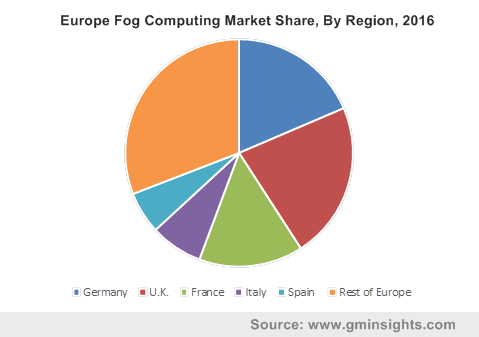Fog computing market to witness a staggering CAGR of 65% over 2017-2024, healthcare sector to drive the application landscape
Publisher : Fractovia | Published Date : 2017-12-29Request Sample
The unprecedented growth of IoT and machine to machine services has led fog computing marketplace to be the next battleground for sustainability and revenue streams. This can be possibly credited to the fact that with rapid development of these applications, the conventional centralized cloud computing platforms are encountering a barrage of severe operational challenges such as low spectral efficiency (SE), high latency, and non-adaptive machine type of communications. In a bid to respond to this challenge, advanced technology is driving a trend that is shifting from centralized cloud computing to a decentralized model. The steep growth graph of fog computing industry can be fundamentally attributed to this paradigm transition. Fog computing is thus integrated as an intermediate layer between the hardware and the cloud to scale down the latency. Backed by a stream of new breed applications particularly in the field of data analytics and management, fog computing industry, pegged a valuation of USD 9 million in 2016.
In an era where the world is persistently struggling to unleash the massive power of Internet of Things, it is imperative to mention that the inherent challenges of cloud computing is providing a significant push to fog computing industry. As per estimates, the number of devices connected to IoT will be almost 50 billion by 2020. In the face of this exceptional emergence of IoT, as per experts’ opinion, an advanced cloud computing platform that breaks through the centralized architecture which would overcome the capacity and latency constraints are earnestly required. Fog computing technology quite effectively serve the purpose, as in these solutions the data is processed or managed at the edge of the network, instead of routing it from a central data center. In fact, it would not be iniquitous to mention that the inherent challenges to cloud computing has left an unfathomable impact on market proliferation.
U.S. Fog Computing Market Size, By Component, 2016 & 2024 ($Mn)

Having being recognized as an economy where technological interventions have always had the most profound impression, U.S. is touted to emerge as one of the most pivotal regional markets. Experts believe that region’s healthcare space which has, of late, undergone a consequential transformation from volume to value based service model, would be primarily responsible for making U.S. the hot spot for fog computing market investors. In fact, statistics depict that the regional healthcare giants have been increasingly integrating IoT devices in their operations in a bid to bring significant improvements in operational efficiency, power consumption, and overall cost reduction. The fact that healthcare applications require real time analysis and are latency sensitive, the growth scope of market from this particular sphere is claimed to be nothing but humougous.
With the increasing penetration of Internet of things in healthcare IT infrastructure, it goes without saying that the requirement of transmitting healthcare cloud to all verticals has become more important, in order to ensure real-time smart communications. Given this backdrop, experts claim, fog computing technology provides the foundational IoT infrastructure requirement for effectuating this process from novelty to reality. In fact, as per experts’ opinion, market is set to remarkably influence value based supply chain model of healthcare fraternity in the coming years, with a considerable improvement in operational efficiency.
Unlike cloud based infrastructure, where the data is accessed from a centralized platform, this advanced version allow end-users to access smaller and much more specific information, a fundamental factor driving the market demand. For instance, under the canopy of fog computing, using predefined authorization and particular user protocols, any data with regard to patient health might get exposed to all the connected platforms through a common interface, but any computational change can only be made at the originating station. Needless to mention, the true potential of fog computing market can only be achieved through extensive research and collaborative approach from both private and government entities. Recently, researchers of Wayne State University made it to the headlines with its envision of developing a collaborative edge computing ecosystem that would connect healthcare related information from incongruent organizations through a common IoT platform. The competitive landscape of fog computing industry space is highly characterized by similar kind of research activities in order exploit the true potential of this emerging technology.
One of the biggest constraints of fog computing industry is the dearth of proper standardization of the technology. In fact, as per reports, end-users find inconsistency which sometimes result in decreased data retrieval and unreachable information. However, some of the renowned tech juggernauts such as Cisco, Intel, Microsoft, and ARM Holdings are showing quite some proactiveness in overcoming the challenge. In what may be touted as an attempt to standardize fog computing technology for future deployment, the aforementioned companies in collaboration with Princeton University have founded OpenFog Consortium in the year 2015. Reportedly, The OpenFog Consortium mainly aims to solve the communication, bandwidth, and latency challenges associated with AI and other innovative digital IT infrastructures. Though still at a nascent stage, with the increasing requirement of optimizing network traffic and reducing the time of transmitting data between cloud computing platform and edge device, it is undeniable that fog computing industry is set to amass remarkable returns over the coming years. Estimates by Global Market Insights, Inc., claim global fog computing market to exceed a valuation of USD 700 million by 2024.